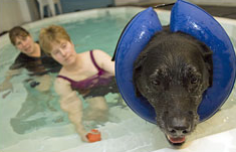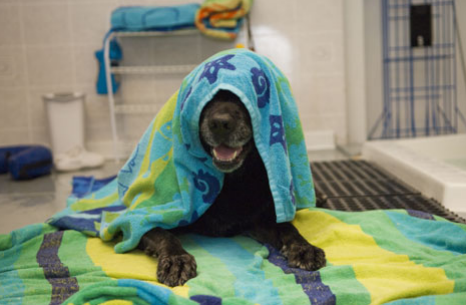

Every doggy into the pool for fitness, fun
By Sharon L. Peters, Special for USA TODAY
By Stacy L. Pearsall for USA TODAY
Published in 2008
Terri Steely, left, and Sue Lee help Cocky out of the pool after a swim session that helps reduce his pain and increase his mobility.
Pooch parents are adding a splash of variety to their dogs’ exercise routines.
Swimming pools for canines are drawing in high-energy pets that relish change-of-pace workouts, as well as older, overweight, injured or post-surgery dogs that benefit from non-weight-bearing exercise to fight flab or build muscle strength, range of motion and flexibility.
Pet pools run the gamut. Some are huge, some small and spa-like; some are purely recreational, others therapy-oriented. Most are equipped with resistance jets, and many are staffed by people who swim with the dogs to guide the activity. They may be part of a veterinarian operation or a rehab center, part of a boarding facility or a stand-alone business. Creative activities abound. Some pools stage doggie birthday parties and other mutt festivities, and in cities where health codes allow, humans and animals can engage in joint-swim opportunities.
Owners who take their dogs to the workouts say nothing compares. Energetic border collie Dillon “licks my face as if to say ‘thank you’ ” after his dips at Paddling Paws in Moncks Corner, S.C., says his owner, Kim Peyser. (It costs $35 for 30 minutes of supervised activity.) Dillon’s body tone, endurance and confidence have improved since he has been swimming regularly with pool owner Terri Steely, but Peyser is most struck by the way Dillon’s “eyes light up” poolside and “the happy sounds he makes.” “Just six or seven years ago, pools were very hard to find,” says canine water-therapy pioneer Cindy Horsfall. She built a therapy pool and began a warm-water treatment business in Redmond, Wash., in 1994 after her dog, Ava, was paralyzed from her front shoulders to hindquarters.
Veterinarians could offer no treatments and recommended euthanasia. Ava improved with warm-water therapy and lived 10 more active years. Horsfall founded La Paw Spa to provide guided swimming for injured, geriatric and post-surgery dogs at $95 an hour. Washington is ground zero for dog pools; it boasts at least 14 in the Puget Sound area. And there has been a tidal surge elsewhere. The Association of Canine Water Therapy, which Horsfall founded in 2005, lists 30 member pools in 12 states, and although there is no clearinghouse or means of tracking them, experts say there are hundreds more.
Swimming has become a veterinarian-recommended activity for dogs working through post-surgical recovery or the aches and pains of aging. “Swimming is the best total-body-conditioning” exercise a dog can engage in, says Lakewood, Colo., veterinary neurosurgeon Patricia Luttgen, who regularly prescribes it for dogs with neurological problems or after surgeries. She also regards swimming as ideal for healthy pets. “It can do the same for dogs that it does for people.”
Denis Marcellin-Little, associate professor of orthopedics at North Carolina State University College of Veterinary Medicine, also believes water therapy often provides potent results. “We don’t have a lot of science” proving the benefits of water therapy for animals, but “it’s intuitive and logical that just as with humans, it may influence the completeness and speed of recovery.” Some pools take a casual, doggie-free-for-all approach. Others are much more structured, requiring appointments, one dog at a time, and a staffer in the water to direct the activity.
Whatever the approach, owners are quickly hooked.
“We never dreamed there would be this kind of response,” says Gary Reihart of Dillsburg, Pa., a horse reeder/trainer who turned his massive heated pool built for Thoroughbreds into Canine Spa in 2001. Dozens of regulars come several times a week ($15 a visit for the first dog, $7 for each additional family dog). It has been
the scene of Frisbee parties, birthday parties and monthly gettogethers where dogs collegially chase water toys.
Joan Klingler’s Lab/cocker spaniel mix Izaak starts “whining and pacing 2 miles away” from Canine Spa. “He can’t wait to get there,” she says.
The indoor pool is a huge improvement over lakes and creeks where there are “always mud and ticks to contend with. He swims for an hour and gets wonderful exercise no matter what the weather, and I don’t need to do anything but drive him there.” When plans were being developed for Red Dog Pet Resort & Spa in Cincinnati, which opened Dec. 18, owners knew that in addition to play rooms, overnight lodging and grooming areas,
there would be a pool, says marketing director Audrey Chapline.
Red Dog’s 16-by-20-foot heated pool with jets, attended by a certified staffer, is by reservation only. The “fun swim” is $25 for 15 minutes; the “fitness swim,” where staffers work the dog through specific movements, is $55 for 30 minutes. Whatever the price, many dog owners are convinced of the value of pool time.
Black Lab Cocky, 9, began swimming at Paddling Paws a few months ago as Sue Lee’s final hope to reduce his pain and improve mobility. He had had surgery on both rear legs for a deformity and was on potent medication for severe arthritis. “He’d hobble a couple of steps, and that was about it,” Lee says. But in the pool, “he’s like Orca.” After just a few swim sessions, “he could run across the yard.” And now, a few months into it, his medications have been cut in half, and “he can walk for an hour at a time.”

Cocky, a black Labrador retriever, dries off after a swim session at the Paddling Paws swimming pool in Moncks Corner, S.C. Cocky, 9, was born with deformed hind legs and has severe arthritis. “The pool has greatly improved the quality of his life,” owner Sue Lee says. “He smiles now.”
